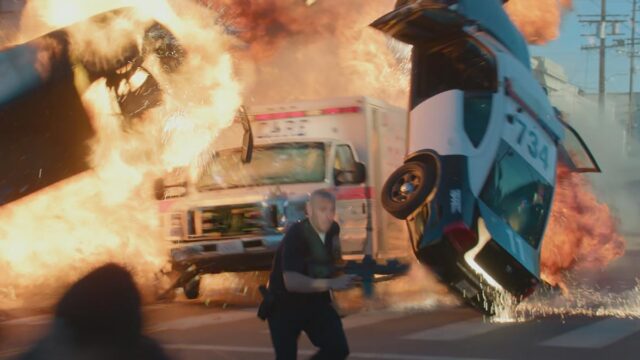Ambulance: Today Was a Good Day, by David Bax

Generally speaking, the problems I’ve had with Michael Bay’s films in the past don’t seem to be the things that most of his detractors point to. In fact, I can boil pretty much all of my distaste for his work down to one word: Comedy. The humor in most of Bay’s movies tends to be loud, frattish, often dependent on racial or physical stereotypes and pretty much always unfunny. His newest film, Ambulance, does make some light attempts at producing laughs, including self-aware references to both The Rock and Bad Boys. But it almost completely sidesteps this pitfall by simply not allowing room for anything other than its own velocity. Once the action kicks in, which happens gloriously early on, it does not stop. There’s barely room to breathe in Ambulance, much less to crack wise.
Now, if your complaints about Bay’s work run to other arenas, you might be in for a rough time. His camera ranges from merely restless to super-agitated, vibrating with the tires on the road or zooming up and along the walls of buildings. And the film’s editing feels like being punched in the face; I still don’t know how the ambulance gets out of the Los Angeles River and back onto the freeway but I don’t care.
And if you’re put off by the musclehead values and morality of the director’s movies, you won’t find that changed up here at all. The leads (Yahya Abdul-Mateen II and Jake Gyllenhaal) are literal bros who, fleeing a bank robbery gone wrong, hijack an ambulance already inhabited by an EMT (Eiza González) and a wounded cop (Jackson White). He’s wounded because one of the bros shot him but you can tell that bro is actually a good dude based on which other people he chooses to shoot for the rest of the movie.
That’s enough, though, about how Ambulance does and doesn’t compare to other Michael Bay movies. Let’s address how it does and doesn’t compare to other movies of its ilk, meaning contemporary wide-release studio genre pictures. I’m not savvy enough to notice computer graphics every time they’re employed in a movie and I’m not naïve enough to claim a film doesn’t have any just because I didn’t notice them. But I can tell you that Ambulance feels analog and real in a way that standard tentpoles just don’t anymore. If forward momentum is the primary concern of the action, a close secondary is brutal physicality. Ambulance is never goopy or weightless. It’s a movie of metal on metal, metal on concrete, metal on bodies and metal on fire.
This verisimilitude extends to the film’s setting. Ambulance is not incidentally a Los Angeles movie. Sure, it takes some minor liberties; it’s odd enough that the very recognizable (to locals) Los Angeles Convention Center stands in for the lobby of an anonymous office building but it’s super weird that, later in the movie, the convention center shows up again as itself. But it also appears to love the place. González’s character starts the movie with a quick meal at the Grand Central Market with her partner (Colin Woodell), who grew up in the Tarzana neighborhood of the city’s San Fernando Valley. And one of the other bank robbers wears a cap with the logo of regional micro-chain Versailles Cuban Food on it.
But there’s more than just name-dropping going on in Ambulance. Bay so effectively documents the way Los Angeles’ downtown looks and feels right now that it starts to feel like a mission statement. Sidewalk tents, murals, street art depictions of Anthony Fauci… Portraits of the city that are this unromantic and yet this loving are usually made by non-Americans like Agnès Varda, not by privileged native sons like Bay, who generally can’t see beyond their own narrow experience of the place. But Ambulance knows what’s going on and seems to go out of its way to get down a record of a city in transition. Maybe you can chalk up the reference to the Staples Center (which, as of recently, is no longer called that) to timing but he still left the line in the movie. Anyway, it’s too much to be coincidental that we see snipers posting up on the roof of the Los Angeles Times building–which opened in 1935 but now no longer houses the paper’s offices and whose view will soon be drastically altered by new residential towers–and a grab-the-Dramamine drone shot along the new, still under construction Sixth Street Bridge, which is replacing the former viaduct that was demolished against the protests of historians and architectural conservationists. Maybe Bay wants to show us these things because he’s a proud Angeleno. Or maybe it’s because he’s looked up to find himself among the old guard and now he wants to preserve his traditions before this town moves on from him the way it does from everything else.





























